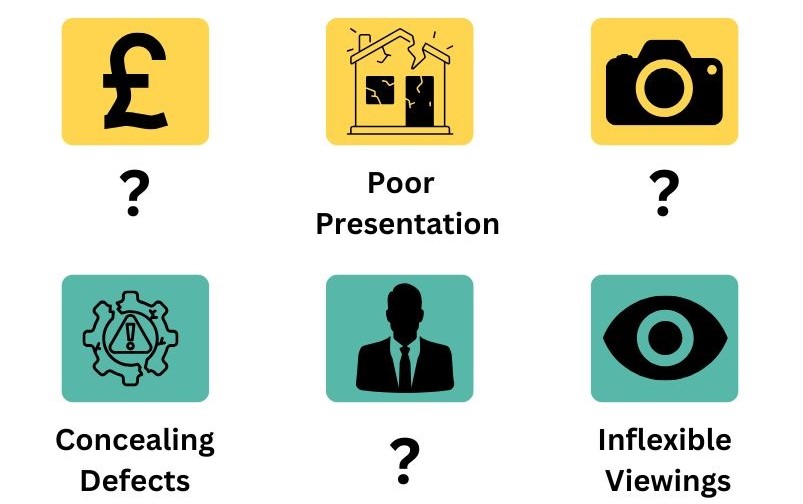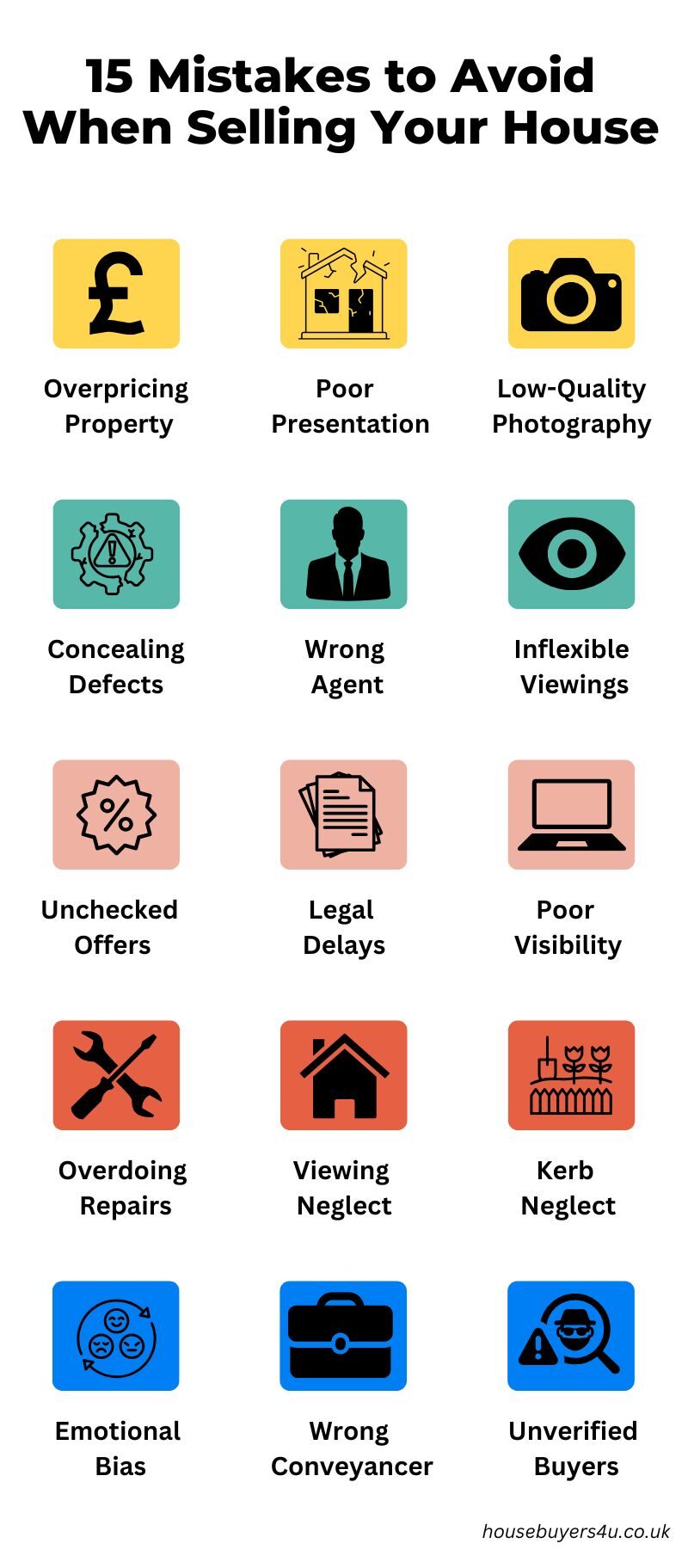Common Mistakes When Selling Your Home: Avoid Costly Pitfalls

Top 3 mistakes to avoid at all costs:
- Pricing too high delays sales—realistic pricing attracts more offers.
- Poor kerb appeal turns buyers away—a clean, staged home boosts interest.
- The highest offer isn’t always best—chain-free buyers mean fewer delays.
- Keep reading to uncover the most common selling mistakes—our costly mistakes table reveals the biggest pitfalls to avoid.
Mistakes to Avoid When Selling Your House
1. Overpricing Your Property
It’s tempting to set a high asking price, hoping to get the best possible deal, but overpricing can turn buyers away before they even book a viewing. If your home sits on the market too long, you’ll likely have to drop the price anyway—sometimes multiple times—making it seem like something’s wrong with it.
Instead, research similar homes in your area, get a few valuations, and price it realistically from the start to attract serious buyers quickly.
Why Overpricing Your Home Can Cost You the Sale
| Buyer Type | Potential Issue | What You Can Do | Ideal Situation |
|---|---|---|---|
| Buyer in a chain | Sale depends on their home selling first, which can cause delays. | Ask if they’ve already sold their home or if they have a buyer lined up. | A chain-free buyer or a buyer whose sale is already close to completion. |
| No mortgage approval | Mortgage rejections can cause the sale to fall through. | Ensure the buyer has a Mortgage Agreement in Principle (AIP). | A cash buyer or a buyer with full mortgage approval. |
| First-time buyer with delays | May take longer to secure a mortgage and complete paperwork. | Confirm they have a conveyancer and lender in place. | A first-time buyer with mortgage approval and a solicitor ready. |
| Investor looking for a deal | May try to renegotiate price at the last minute. | Ask about their funding source and investment goals. | A committed buyer willing to pay close to asking price. |
2. Poor Home Presentation
A study by Strutt & Parker found that 76% of buyers believe first impressions are crucial when visiting a property, and 66% feel the same about online viewings
Buyers need to picture themselves living in your home, and that’s hard to do if it’s cluttered, dark, or messy. A well-presented home feels inviting and cared for, while a neglected one raises red flags about hidden problems.
Tidy up, let in natural light, and consider small updates like a fresh coat of paint or neutral décor. It doesn’t have to be perfect, but creating a warm, welcoming space makes a big difference.
3. Using Low-Quality Photography
Your listing photos are often the first thing buyers see, and if they’re dark, blurry, or poorly framed, they might scroll right past your home. Good photos help buyers connect with your space before they even step inside. If professional photography isn’t an option, make sure to take bright, high-quality images that showcase your home’s best features—clear, well-lit pictures can make all the difference.
Our sales team at Housebuyers4u has seen firsthand that high-quality listing photos attract far more enquiries than dark, blurry, or poorly framed images. Our data shows that professional-standard photos can generate 93% more leads than low-quality ones. From our experience, strong visuals not only boost interest but also help homes sell faster and at better prices.
4. Hiding Property Issues
It’s tempting to gloss over small problems or hope buyers won’t notice bigger ones, but they almost always will—either during viewings or in a survey. Trying to hide issues can backfire, leading to broken trust, lower offers, or even a collapsed sale. If there’s something that needs fixing, be upfront about it.
A little honesty goes a long way, and sometimes, just acknowledging an issue and factoring it into the price can keep things moving smoothly.
9. Ignoring Marketing & Online Exposure
Most buyers start their search online, so if your home isn’t on Rightmove, Zoopla, or other major platforms with great photos and a strong description, you’re missing out.
Poor marketing can mean fewer viewings and a slower sale—make sure your home is getting the visibility it deserves.
10. Overdoing Repairs & Upgrades
It’s easy to think major renovations will boost your home’s value, but expensive upgrades don’t always pay off.
Instead of big projects, focus on simple fixes—fresh paint, updated lighting, and minor repairs that make your home feel well-maintained without overspending.
11. Not Preparing for Viewings
Buyers need to picture themselves living in your home, and a messy, dark, or cluttered space makes that difficult. Tidy up, let in natural light, and create a welcoming feel—even small efforts can make a big impact.
Related Read: How to stage your home for sale
12. Ignoring Kerb Appeal
First impressions start before buyers step inside. A scruffy exterior, overgrown garden, or dirty windows can put them off instantly.
Keep it simple—tidy up, jet wash paths, and refresh paintwork to create an inviting entrance.
Click here to learn 11 ways on how to improve your homes kerb appeal
13. Getting Too Emotionally Attached
Selling a home is personal, but letting emotions cloud decisions can slow things down.
Viewing your home as a property, not just a place full of memories, will help with pricing, negotiations, and ultimately securing a smooth sale.
14. Hiring the Wrong Conveyancer
A slow or unresponsive solicitor can drag out the process, frustrate buyers, and even risk the sale falling through.
Choose a conveyancer with good reviews, clear communication, and a reputation for efficiency to keep things moving smoothly.
What Our Sellers Say:
"Really good information, was honest and upfront and had valuations done at own expense. Provided us with solicitors as well as covering the cost, and it was a smooth transaction. Yes, the offer was lower than market value, but we needed a quick sale and we didn’t have to sign anything up front.
Click here to read the full review on Trustpilot
15. Not Vetting Potential Buyers
An offer means nothing if the buyer isn’t financially ready.
Accepting an offer from someone who hasn’t secured a mortgage or is stuck in a long chain can lead to delays or even a collapsed sale. Always check their position first to avoid setbacks.
Expert quote from our property expert Paul:
"A high offer means nothing if the buyer can’t follow through. Always check for mortgage approval or, better yet, prioritise chain-free buyers—they’re far less likely to cause delays or pull out."
Learn More About How to Sell Your House Fast in the UK
- Best Time of the Year to Sell Your House
- Should I Sell My House to Pay Off Debt?
- Selling Your House After Divorce
- How to Sell an Inherited Property Fast
- Sell House Due to Job Relocation
- Selling your House Due to Health Issues
- Selling a House in Poor Condition
- How to Sell a House with Bad Tenants
- How to Sell your Tenanted Property
- How to Sell My Flat Quickly
- How to Sell Your House to an Investor Fast
- How to Sell your House Online
- Selling Your House Without an Estate Agent in the UK
- How to Sell your Empty House Fast in the UK
- How Long Does It Take to Sell a House UK?
- Selling your Non-Standard Construction House
- How to Stage a House for Sale
- Sell My House Fast for Market Value UK
- Selling your House Due to Financial Difficulties
- Selling a House in Poor Condition
- What is Gazundering?
- Selling Your House Due to Relocation or Emigration?

